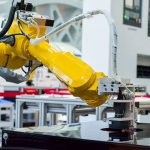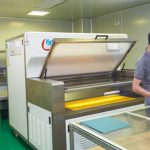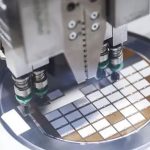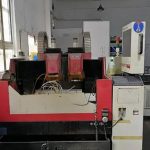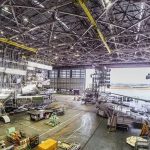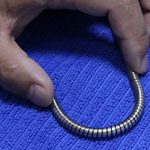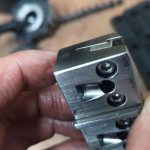Deprecated: get_settings is deprecated since version 2.1.0! Use get_option() instead. in /www/sites/alloy.wiki/index/wp-includes/functions.php on line 4862
The advanced manufacturing technology of cnc precision machining manufacturers is an integrated technology that integrates many modern advanced technologies in the manufacturing industry, mainly including precision, ultra-precision machining technology and manufacturing automation. The following is a brief analysis from Alloy Wiki.
The cutting process of precision cutting:
In the precision cutting of cnc precision machining manufacturers, the micro-cutting method is adopted, the cutting depth is small, and the cutting function is mainly undertaken by the cutting edge arc of the tool. Whether the chips can be cut from the material to be processed mainly depends on the force of the material point of the material to be processed at the arc of the cutting edge of the tool.
In order to study the micro-cutting process and understand the various phenomena in the cutting process, first analyze the transitional cutting process. CNC precision machining manufacturers take the cutting situation of the rotary tool as an example to analyze the contact between the cutting edge of the tool and the surface of the workpiece and the deformation of the workpiece material during the transitional cutting process. Taking Alloy Wiki cnc precision machining as an example, it is the cutting process of a single-edged rotary tool milling a plane. The dotted line represents the motion trajectory of the cutting edge, and the solid line represents the contour line of the machined surface. Starting from the contact between the cutting edge of the tool and the workpiece, the tool slides a certain distance on the workpiece, and the surface of the workpiece is only elastically deformed. After the cutting edge is removed, the surface of the workpiece can still be restored to its original state. This sliding of the cutting edge on the surface of the workpiece is called elastic sliding.
As the tool continues to rotate, the amount of back-grabbing continues to increase, and plastic deformation begins to occur on the surface of the workpiece. In this plastic deformation zone, after the cutting edge slides over the surface of the workpiece, the surface of the workpiece is pierced with groove marks, but this When the material is not really removed. This sliding of the cutting edge on the surface of the workpiece is called plastic sliding.
After the plastic sliding, as the amount of back-grabbing increases, chips are generated on the front, and the cutting process begins. Due to the elastoplastic deformation on the surface of the workpiece, the trajectory of the cutting edge and the contour formed by the surface to be processed will not overlap. By changing the cutting angle of the tool, the maximum interference depth between the tool and the workpiece can be changed in turn, so that the curve can be obtained. When the maximum interference depth of the cutting edge is very small, that is, the cutting angle is very small, it is the cutting state.
At this time, the tool only slides on the surface of the workpiece, and there is no trace of the tool cutting on the surface of the workpiece. All the contact lengths between the tool and the processed surface belong to the elastic deformation area.
When the maximum interference depth between the tool and the workpiece reaches a certain value, a cutting state is formed. There is an elastic sliding area within a length of the beginning of cutting, and then enters the plastic deformation area. After the cutting edge slides, groove marks will be left in the plastic deformation area, but no chips are generated. Continue to increase the maximum interference depth between the tool and the upper part to form a cutting state. In the initial contact between the cutting edge and the surface of the workpiece, it is an elastic sliding area. As the amount of back-grabbing increases, it becomes a plastic sliding area. In the cutting area, the surface of the workpiece is a groove formed by plastic deformation and chip removal. With the reduction in the amount of back-grabbing, it then transitions to the plastic deformation zone and the elastic deformation zone.
CNC precision machining manufacturers must point out that there is also an elastic deformation zone in the plastic sliding zone, and there are both chip removal zones, plastic deformation zones and elastic deformation zones in the cutting zone.
Therefore, in the process of micro-cutting by cnc precision machining manufacturers, part of the material near the arc of the cutting edge of the tool is removed, and the other part is squeezed to produce elastic and plastic deformation. The cutting effect of ultra-precision machining is formed by the cutting action and rolling action of the tool, and in the process of forming the processed surface, the accompanying rolling action occupies a large proportion, that is, the quality of the processed surface is to a large extent The upper is affected by the rolling effect.
CNC precision machining manufacturers’ precision machining technology is one of the most important development directions of modern machinery manufacturing. It plays a vital role in improving the performance and quality of electromechanical products and developing high-tech. It has become a success in international competition. Key technology. The development of my country’s manufacturing industry has entered a stage of rapid development. The introduction of advanced equipment and the influx of a large number of professionals have rapidly improved the level of manufacturing in many coastal areas. With the deepening of the scientific and democratization of national decision-making, it is believed that my country’s manufacturing industry will develop faster and more healthily.
Link to this article:About precision machining technology and testing
Reprint Statement: If there are no special instructions, all articles on this site are original. Please indicate the source for reprinting:Alloy Wiki,thanks!^^


